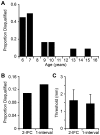Tactile spatial acuity in childhood: effects of age and fingertip size
- PMID: 24454612
- PMCID: PMC3891499
- DOI: 10.1371/journal.pone.0084650
Tactile spatial acuity in childhood: effects of age and fingertip size
Abstract
Tactile acuity is known to decline with age in adults, possibly as the result of receptor loss, but less is understood about how tactile acuity changes during childhood. Previous research from our laboratory has shown that fingertip size influences tactile spatial acuity in young adults: those with larger fingers tend to have poorer acuity, possibly because mechanoreceptors are more sparsely distributed in larger fingers. We hypothesized that a similar relationship would hold among children. If so, children's tactile spatial acuity might be expected to worsen as their fingertips grow. However, concomitant CNS maturation might result in more efficient perceptual processing, counteracting the effect of fingertip growth on tactile acuity. To investigate, we conducted a cross-sectional study, testing 116 participants ranging in age from 6 to 16 years on a precision-controlled tactile grating orientation task. We measured each participant's grating orientation threshold on the dominant index finger, along with physical properties of the fingertip: surface area, volume, sweat pore spacing, and temperature. We found that, as in adults, children with larger fingertips (at a given age) had significantly poorer acuity, yet paradoxically acuity did not worsen significantly with age. We propose that finger growth during development results in a gradual decline in innervation density as receptive fields reposition to cover an expanding skin surface. At the same time, central maturation presumably enhances perceptual processing.
Conflict of interest statement
Figures





Similar articles
-
Diminutive digits discern delicate details: fingertip size and the sex difference in tactile spatial acuity.J Neurosci. 2009 Dec 16;29(50):15756-61. doi: 10.1523/JNEUROSCI.3684-09.2009. J Neurosci. 2009. PMID: 20016091 Free PMC article.
-
Postural stabilization from fingertip contact II. Relationships between age, tactile sensibility and magnitude of contact forces.Exp Brain Res. 2005 Jul;164(2):155-64. doi: 10.1007/s00221-005-2238-5. Epub 2005 Mar 8. Exp Brain Res. 2005. PMID: 15754171
-
A physical constraint on perceptual learning: tactile spatial acuity improves with training to a limit set by finger size.J Neurosci. 2013 May 29;33(22):9345-52. doi: 10.1523/JNEUROSCI.0514-13.2013. J Neurosci. 2013. PMID: 23719803 Free PMC article.
-
Tactile spatial acuity enhancement in blindness: evidence for experience-dependent mechanisms.J Neurosci. 2011 May 11;31(19):7028-37. doi: 10.1523/JNEUROSCI.6461-10.2011. J Neurosci. 2011. PMID: 21562264 Free PMC article.
-
Tactile roughness discrimination of the finger pad relies primarily on vibration sensitive afferents not necessarily located in the hand.Behav Brain Res. 2012 Apr 1;229(1):273-9. doi: 10.1016/j.bbr.2012.01.018. Epub 2012 Jan 17. Behav Brain Res. 2012. PMID: 22265887
Cited by
-
An individual's skin stiffness predicts their tactile discrimination of compliance.J Physiol. 2023 Dec;601(24):5777-5794. doi: 10.1113/JP285271. Epub 2023 Nov 9. J Physiol. 2023. PMID: 37942821 Free PMC article.
-
The extraordinary enigma of ordinary tickle behavior: Why gargalesis still puzzles neuroscience.Sci Adv. 2025 May 23;11(21):eadt0350. doi: 10.1126/sciadv.adt0350. Epub 2025 May 23. Sci Adv. 2025. PMID: 40408489 Free PMC article. Review.
-
Development of local-global preference in vision and haptics.J Vis. 2023 Apr 3;23(4):6. doi: 10.1167/jov.23.4.6. J Vis. 2023. PMID: 37097225 Free PMC article.
-
Multimodal Body Representation of Obese Children and Adolescents before and after Weight-Loss Treatment in Comparison to Normal-Weight Children.PLoS One. 2016 Nov 22;11(11):e0166826. doi: 10.1371/journal.pone.0166826. eCollection 2016. PLoS One. 2016. PMID: 27875563 Free PMC article. Clinical Trial.
-
No evidence for sex differences in tactile distance anisotropy.Exp Brain Res. 2022 Feb;240(2):591-600. doi: 10.1007/s00221-021-06301-7. Epub 2022 Jan 4. Exp Brain Res. 2022. PMID: 34984563
References
Publication types
MeSH terms
LinkOut - more resources
Full Text Sources
Other Literature Sources

